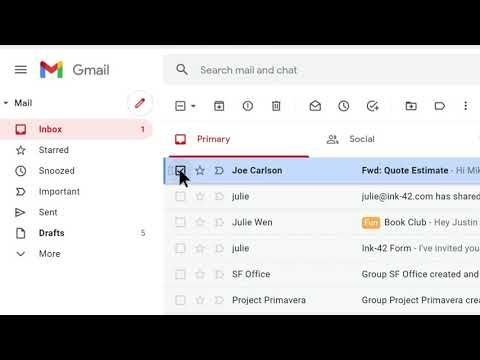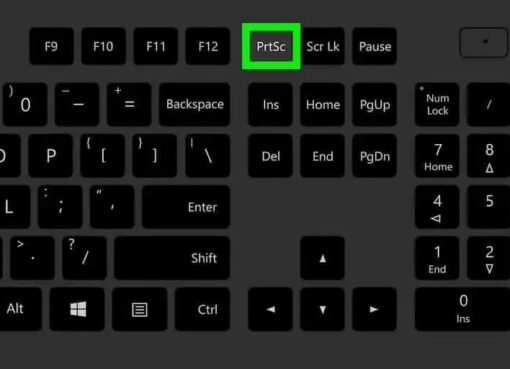In our increasingly digital world, email has become an integral part of our communication. Gmail, Google’s popular email service, offers a plethora of features to help manage your email efficiently. One such feature is archiving, which allows you to tidy up your inbox without permanently deleting important messages. In this comprehensive guide, we will delve deep into the world of archiving emails in Gmail. We’ll explore the art of archiving emails, how to find archived emails using various methods, and how to ensure nothing is lost in your digital mail ecosystem.
How to Archived Emails in Gmail
Archiving emails is a crucial skill to master for effective email management. It allows you to remove emails from your inbox while retaining easy access to them. In this chapter, we will break down the archiving process step by step for different platforms.
Archiving Emails on the Gmail Desktop App
Gmail on your desktop offers a convenient and user-friendly interface for archiving emails. Here’s how to do it:
a. Open Gmail on your desktop.
b. Select the email you wish to archive.
c. Click the “Archive” button or the archive symbol (an icon that resembles a box with a downward arrow) at the top of your inbox. The email will be moved to the “All Mail” label.
Using this method, you can swiftly archive messages and maintain a clutter-free inbox.
Archiving Emails on the Gmail Android App
For Android users, Gmail’s mobile app provides an efficient way to archive emails:
a. Open the Gmail app on your Android device.
b. Long-press on the email you want to archive.
c. Tap the archive symbol or “Archive” in the toolbar at the top of the screen.
By following these steps, you can keep your Android inbox organized with ease.
Archiving Emails on the Gmail iPhone App
Managing your emails on the go is made easy with the Gmail app on your iPhone. Here’s how to archive emails:
a. Open the Gmail app on your iPhone.
b. Swipe left on the email you wish to archive and tap the “Archive” option.
With this method, you can ensure your iPhone inbox stays clutter-free.
Using the All Mail Label to Find Archived Emails in Gmail
Once you’ve archived your emails, it’s essential to know how to retrieve them when needed. Gmail stores archived emails in a dedicated folder called “All Mail.” In this chapter, we will explore how to access this folder and find your archived emails.
Accessing Archived Emails via the “All Mail” Label
“All Mail” is the repository for all your archived emails. To access it on the Gmail desktop app:
a. On the Gmail desktop app, scroll down the left sidebar and click on “All Mail.” This label contains all your archived emails.
The “All Mail” label serves as a repository where all your archived emails are readily available.
Finding Archived Emails Using the Search Bar
If you’re looking for a specific archived email, use the Gmail search bar to locate it. Follow these steps:
a. Click on the search bar at the top of your Gmail screen.
b. Enter relevant keywords related to the email you’re searching for.
c. Gmail’s powerful search functionality will help you find the archived email you’re looking for.
Utilizing the search bar is a swift and efficient method to retrieve archived emails.
When Gmail Search Is Not Finding Emails
Occasionally, you might experience issues with Gmail’s search functionality not yielding the desired results. In such cases, ensure you’ve entered the correct search terms and try again. It’s essential to use specific keywords to pinpoint your archived emails accurately.
How to Undo Archived Emails
We will explore the process of undoing archived emails in Gmail, a critical aspect of email management that allows you to retrieve previously archived messages back into your inbox. This chapter focuses on the steps required to reverse the archiving process and make your archived emails easily accessible once again.
Go to the “All Mail” Label on the Gmail Desktop App
To retrieve archived emails from the “All Mail” folder and move them back to your inbox, follow these simple steps:
a. Open Gmail on your desktop.
b. Locate the “All Mail” label in the left sidebar. This label serves as the repository for all your archived emails.
The “All Mail” label is where all your archived emails are stored, and accessing it is the first step to undoing your archived messages.
Retrieve the Archived Email
a. Inside the “All Mail” folder, you will find a list of all your archived emails.
b. Locate the specific archived email you wish to unarchive. You can use the search bar in the “All Mail” label to narrow down your selection if needed.
Once you’ve located the email you want to unarchive, you’re ready to proceed.
Unarchive the Email
a. Open the archived email by clicking on it.
b. In the email view, you’ll find a set of options and icons. Look for the “Move to Inbox” option, often depicted as an inbox symbol, and click on it.
Clicking “Move to Inbox” will reverse the archiving process, moving the email from the “All Mail” label back into your inbox.
By following these steps, you can seamlessly undo the archiving of emails and ensure they are readily accessible in your inbox once more. This is a valuable feature for managing your Gmail messages, as it provides the flexibility to reorganize your emails as your priorities and needs change.
Recovery Period and Permanent Deletion
It’s important to note that archived emails are typically retained in the “All Mail” folder indefinitely, unless you choose to permanently delete them. However, Gmail’s behavior may vary based on your settings and storage capacity. Gmail’s search and filtering tools, in addition to the “All Mail” label, allow you to recover archived emails even if they are relatively old. Nonetheless, it’s crucial to remember that permanently deleted emails may not be recoverable. Always exercise caution when choosing to permanently delete emails, and consider archiving as a safer alternative to declutter your inbox.
In conclusion, the ability to undo archived emails in Gmail is a fundamental feature for effective email management. It ensures that archived messages are never lost, providing a safety net for retrieving important information and correspondence at any time. This feature is especially valuable for those who want to maintain an organized and clutter-free inbox while retaining easy access to their archived emails. With these straightforward steps, you can confidently manage your Gmail inbox and adapt to changing priorities and needs with ease.
The Importance of Archiving in Gmail
Archiving emails in Gmail is not merely a mundane task but a valuable practice that can greatly enhance your email management. In this chapter, we will delve deeper into the significance of Gmail archiving and the numerous benefits it offers.
Organized Inbox
One of the most immediate benefits of archiving is that it helps maintain a well-organized inbox. When you archive an email, it disappears from your primary inbox, reducing visual clutter and making it easier to focus on the most recent and important messages. This streamlined view allows for more efficient email processing and can help boost your productivity. With a clutter-free inbox, you can quickly spot and respond to essential emails without sifting through a sea of less important ones.
No Risk of Deletion
One of the most significant advantages of archiving is that it eliminates the risk of accidentally deleting important emails. When you delete an email, it’s gone for good, but when you archive, the message is safely stored in the “All Mail” folder. This acts as a safety net, ensuring that even if you archive an email by mistake, you can always retrieve it when needed. You won’t have to worry about losing vital information or correspondence due to accidental deletions.
Efficient Email Management
Archiving is a powerful tool for efficient email management. It enables you to declutter your inbox without losing access to archived emails. Instead of deleting messages you might need in the future, you can archive them, making it easy to retrieve them later. This is especially valuable in a professional context where archived emails may contain important references, attachments, or legal documentation. In such cases, Gmail archiving serves as a dependable filing system, ensuring that your emails are accessible whenever you need them.
Improved Email Search
Another advantage of archiving is its impact on email search. With fewer emails in your inbox, searching for specific messages becomes faster and more accurate. Gmail’s search feature is powerful, but it becomes even more effective when your inbox is organized. By archiving non-essential emails, you reduce the noise in your search results and improve the likelihood of finding the message you’re looking for. This is particularly beneficial when you need to retrieve information or past correspondence quickly.
Email Privacy and Security
Archiving can also contribute to your email’s privacy and security. By keeping sensitive or confidential emails out of your primary inbox and archiving them, you reduce the chances of accidentally exposing private information to prying eyes. This is a significant advantage for individuals and businesses alike, as it helps maintain email confidentiality and ensures that sensitive data remains secure.
In conclusion, Gmail archiving is more than just a tool to clear your inbox; it’s a powerful strategy for efficient email management. It keeps your inbox organized, ensures the safety of your emails, and facilitates quick and accurate email retrieval. These benefits make Gmail archiving an essential practice for anyone looking to maintain a well-organized and productive email experience.
Advanced Gmail Archiving Techniques
We’ll explore advanced techniques and strategies to take your Gmail archiving skills to the next level. These techniques are designed to further enhance your email management and retrieval process.
Categorizing Archived Emails
While Gmail’s “All Mail” label serves as a repository for archived emails, you can improve your email organization by creating custom labels and filters. This allows you to categorize archived emails based on specific criteria, such as sender, subject, or project. By labeling archived emails, you can quickly identify and retrieve messages related to a particular category, client, or project. This advanced archiving technique is particularly beneficial for those dealing with a high volume of emails and complex email workflows.
Using Keyboard Shortcuts for Archiving
Gmail provides a range of keyboard shortcuts to streamline your archiving process. These shortcuts allow you to perform actions quickly without the need for a mouse or touchpad. For instance, you can press “E” to archive an open email, “V” to move an email to a label, or “I” to mark an email as read. Mastering these shortcuts can significantly speed up your archiving and email management tasks, making you a Gmail power user.
Bulk Archiving
If you have accumulated a large number of emails that need archiving, you can use the bulk archiving feature to save time. This technique allows you to select multiple emails at once and archive them in a single action. To do this, select the emails you want to archive, click the “Archive” button, and watch as your inbox becomes significantly lighter. This method is particularly useful for periodic email clean-up or when transitioning to a more organized email system.
By adopting these advanced Gmail archiving techniques, you can further streamline your email management, improve your efficiency, and maintain a highly organized inbox. Whether you need to categorize, employ keyboard shortcuts, or tackle a backlog of emails, these techniques will empower you to make the most of Gmail’s archiving capabilities.
Archiving on Different Gmail Platforms
We will explore how to archive emails on various Gmail platforms, catering to users of the Gmail desktop app, the Gmail Android app, and the Gmail iPhone app. Each platform offers unique features and methods for archiving emails, ensuring a consistent and streamlined experience regardless of the device you use.
Archiving with the Gmail Desktop App
The Gmail desktop app is a powerful platform for managing your email, and it offers several convenient options for archiving emails.
– Archive Button: When using the desktop app, you’ll find the prominent “Archive” button at the top of your inbox. This button is represented by an archive symbol, often depicted as a box with a downward arrow. Select the email you wish to archive and click this button to swiftly move it to the “All Mail” label. The archive symbol simplifies the archiving process and allows for efficient inbox organization.
– Keyboard Shortcuts: Gmail’s desktop app also supports keyboard shortcuts. By pressing “E” while an email is selected, you can archive it quickly. Keyboard shortcuts are a valuable time-saving tool, especially for users who prefer navigating Gmail without a mouse.
– Drag-and-Drop: For a more visual approach, you can simply drag an email from your inbox and drop it into the “All Mail” label in the left sidebar. This drag-and-drop method is intuitive and offers an alternative to using the “Archive” button.
Archiving with the Gmail Android App
The Gmail Android app provides a mobile-friendly interface for archiving emails on the go.
– Long-Press and Archive: To archive emails on your Android device, open the Gmail app, and long-press the email you want to archive. This action will select the email, and a toolbar at the top of the screen will provide an “Archive” option. Tapping this option will quickly move the selected email to your archive, helping you maintain a tidy inbox, even when you’re away from your computer.
Archiving with the Gmail iPhone App
Managing emails using the Gmail app on your iPhone is straightforward, and archiving can be accomplished with a swipe.
– Swipe and Archive: In the Gmail iPhone app, simply swipe left on the email you wish to archive. You’ll notice an “Archive” option appear as you swipe. This convenient gesture-based approach makes archiving emails quick and efficient, perfect for users who want to keep their mobile inbox organized.
By offering a range of methods for archiving emails, Gmail ensures that users can seamlessly maintain an organized inbox, regardless of their chosen platform. These features and methods are user-friendly, making archiving a hassle-free process that enhances email management across different devices. Whether you’re at your desktop, using an Android device, or on your iPhone, Gmail’s archiving capabilities provide consistency and convenience.
Conclusion
In this concluding chapter, we’ll summarize the essential points covered in this guide and reiterate the benefits of Gmail archiving. We’ll encourage you to embrace archiving as a key practice for efficient email management.
Gmail archiving is a powerful feature that can transform the way you manage your emails. With a robust understanding of archiving and the methods to find archived emails, you can maintain an organized inbox and ensure that no important message is ever lost. Whether you’re using the Gmail desktop app, Android app, or iPhone app, the principles of archiving remain the same. By practicing effective email management, you can streamline your digital communication and improve your productivity. So, go ahead, start archiving, and take control of your Gmail inbox today!
Also see: How to Sign Out of Google and Gmail
Frequently Asked Questions:
- What Happens When You Archive an Email in Gmail?
When you archive an email, it is removed from your inbox but not deleted. It is stored in the “All Mail” folder for easy retrieval. - How to Check Archived Emails in Gmail?
You can check archived emails in Gmail by accessing the “All Mail” label or using the search bar with relevant keywords. - How to View Archived Emails in Gmail?
To view archived emails, open the “All Mail” label or use the search bar to locate specific archived emails. - How to Retrieve Archived Emails Back to Your Inbox?
To retrieve archived emails back to your inbox, locate the email in the “All Mail” label and click “Move to Inbox.”
- Time Difference Between India and United States - April 28, 2024
- How to Turn Off Sticky Keys on Windows 10 - April 27, 2024
- What is a Hotmail? - April 26, 2024




